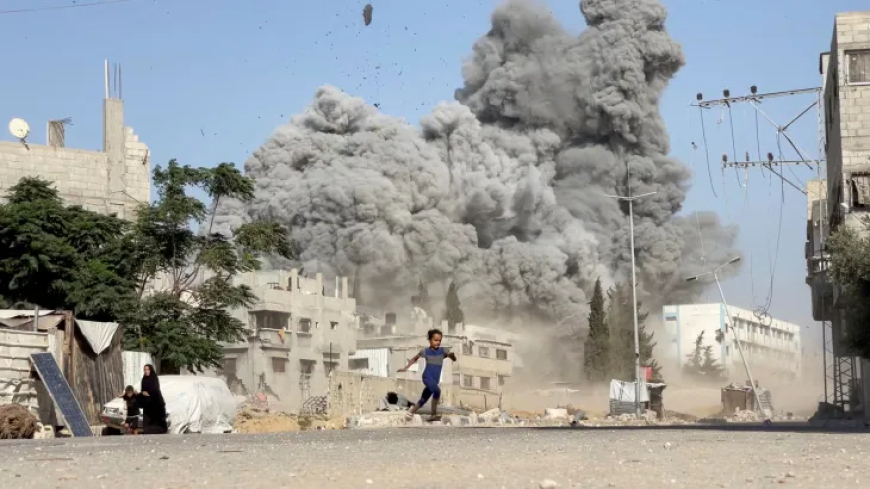Israel opens new route out of Gaza City, death toll passes 65,000
Gaza death toll passes 65,000 amid Israel–Hamas war. Israel opens a new evacuation route as UN urges ceasefire. Humanitarian crisis deepens in the Middle East.

The humanitarian crisis in Gaza has reached devastating new levels, with the death toll surpassing 65,000, according to international agencies. At the same time, Israel has opened a new evacuation route out of Gaza City in a move described as “a temporary humanitarian measure.”
The development comes amid intensifying calls from the United Nations and global leaders for an immediate ceasefire to end the ongoing bloodshed.
The war between Israel and Hamas has entered yet another grim chapter. Aid organizations confirm that:
-
Over 65,000 people have died since the conflict escalated.
-
The majority of casualties are women and children.
-
Thousands remain trapped under the rubble of destroyed neighborhoods.
Hospitals are overwhelmed, struggling to cope without adequate medicine, electricity, or fuel. Health workers warn that disease outbreaks could cause further loss of life if international aid does not arrive quickly.
“Gaza is becoming unlivable. Every hour brings new casualties and deeper despair,” said a spokesperson for Médecins Sans Frontières (MSF).
In response to mounting pressure, Israel announced the opening of a new evacuation corridor from northern Gaza.
-
The route is meant to allow civilians to leave Gaza City safely.
-
Thousands of displaced residents were seen using the corridor within hours of its opening.
-
However, rights groups say the evacuation remains risky and chaotic, with little clarity on safety once civilians reach the southern zones.
The Israeli Defense Forces (IDF) stated the move was designed to “minimize civilian harm” as operations continue against Hamas fighters in urban areas.
The United Nations Security Council has held multiple emergency sessions but failed to secure a binding ceasefire.
-
UN Secretary-General António Guterres called the situation “an endless nightmare for civilians.”
-
The European Union and Arab League urged restraint and immediate humanitarian aid access.
-
The United States has supported Israel’s right to self-defense but pushed for “temporary humanitarian pauses.”
Meanwhile, protests erupted in major cities worldwide, with demonstrators demanding an end to the violence and more action from global powers.
For ordinary Palestinians, life has become a fight for survival.
-
Food shortages have left families dependent on limited aid convoys.
-
Access to clean water has collapsed, forcing many to rely on unsafe sources.
-
Schools and mosques have been turned into makeshift shelters.
“We left our home with nothing. Every night we fear for our children’s lives,” shared Amina, a displaced mother sheltering in Khan Younis.
The UN estimates that over 1.5 million people are now internally displaced within Gaza.
Despite blockages and security risks, aid continues to trickle into Gaza:
-
Egypt and Jordan have coordinated limited humanitarian deliveries.
-
The Red Cross has called for protected medical corridors.
-
Qatar and Turkey pledged more funds for emergency relief.
Still, aid agencies warn that current efforts cover less than 20% of the population’s needs.
The conflict has sparked concerns about a wider Middle East crisis.
-
Border tensions have risen with Lebanon and Syria.
-
Regional economies face disruptions in trade and fuel prices.
-
Diplomatic ties between Israel and neighboring Arab states are under strain.
Analysts fear that if the conflict drags on, it may trigger broader instability across the region.
Pressure is mounting for a comprehensive ceasefire agreement.
-
Human rights groups stress that civilian protection must be a priority.
-
Several countries have offered to mediate peace talks.
-
Religious leaders across faiths are urging compassion and dialogue.
However, with both sides holding firm positions, reaching a breakthrough remains difficult.
For Gaza’s people, the immediate future looks uncertain. While the new evacuation route offers some hope of safety, the death toll of over 65,000 highlights the scale of destruction.
The world is watching closely as diplomacy struggles to catch up with the humanitarian emergency. Whether leaders can act swiftly enough may decide not only the fate of Gaza but also the stability of the wider Middle East.
The war in Gaza is no longer just a local conflict; it has become a global humanitarian and political crisis. With over 65,000 lives lost, Israel’s opening of a new evacuation route may provide short-term relief, but the core issue remains unresolved.
Until meaningful ceasefire talks begin, Gaza’s tragedy will continue to unfold — testing the conscience of the international community and the resilience of its people.

 Israr Ahmed
Israr Ahmed